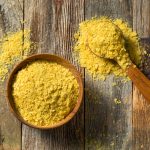All about nutritional yeast plus 5 simple ways to add it to your diet
 (NaturalHealth365) Yeast is a microorganism from the fungus family. You probably know it for its role in raising bread dough and brewing beer. But one type of this fungus, known as nutritional yeast, has recently been making waves in the vegan and vegetarian communities.
(NaturalHealth365) Yeast is a microorganism from the fungus family. You probably know it for its role in raising bread dough and brewing beer. But one type of this fungus, known as nutritional yeast, has recently been making waves in the vegan and vegetarian communities.
This unexpected food source contains an impressive range of nutrients and may offer some important health benefits. Here’s what you may want to know.
THIS fungus may benefit people with diabetes, support immune function, according to research
Saccharomyces cerevisiae is the formal species name for nutritional yeast. Unlike brewer’s and baker’s yeast, it is specifically grown to be consumed as food; yeast cells are killed during the manufacturing process so that they are inactive in the product’s final form.
Nutritional yeast can be found in most natural food stores or online. You can choose unfortified varieties, which contains only the nutrients naturally found in the yeast cells while alive, or fortified nutritional yeast, which contains added (synthetic) nutrients, like folic acid.
While you should look to the label of your chosen product for more information, you can generally expect the following nutrients in a quarter cup serving of nutritional yeast:
- 8 grams (g) of protein (because it contains all nine essential amino acids, nutritional yeast is considered a complete protein source!)
- 3 g of fiber
- B vitamins, including 11.8 milligrams (mg) of thiamine, aka vitamin B1, 9.7 mg of riboflavin, or vitamin B2, 5.9 mg of vitamin B6, and 17.60 micrograms of vitamin B12
Nutritional yeast also contains other nutrients like iron, potassium, zinc, selenium, and calcium – not bad for just 60 calories per serving!
There’s still a lot to learn, specifically about nutritional yeast and its impact on human health. But, so far, we do have some promising hints.
According to a 2015 paper from Current Topics in Nutraceutical Research, nutritional yeast can be considered a probiotic. It displays cancer-preventive properties and may be particularly beneficial for people with diabetes, thanks to its potential to lower fasting blood sugar levels. Another study from the peer-reviewed journal Nutrients suggests that it may improve the bioavailability of minerals, ease intestinal diseases, and support immune function.
And given its dense dose of B vitamins, it could also have a role in supporting healthy skin, nails, hair, and more.
How do you add nutritional yeast into your diet? Try these five simple ideas
People who eat it love it for its cheesy, nutty flavor. This simple sprinkling enhances the savory taste of your dishes and can be used in a number of creative ways. Try this:
- Tossed onto popcorn or over a salad
- Sprinkled onto avocado toast
- Mixed into stuffing
- Added to scrambled eggs
- Mixed into risotto or in any other recipe as a stand-in for Parmesan cheese
If it’s new to you, nutritional yeast should be introduced slowly. It contains a lot of fiber which may lead to gastrointestinal upset if over-consumed. Plus, some people with inflammatory bowel diseases like Crohn’s disease may find that consuming it exacerbates their symptoms. So, if you’re being medically supervised or have a chronic health condition, consider chatting with your provider before sprinkling it onto your favorite savory meals.
Sources for this article include:
Healthline.com
Researchgate.net
Womenshealthmag.com
NIH.gov
FAO.org
Medicalnewstoday.com



